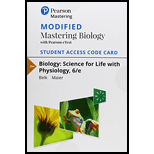
EP BIOLOGY:SCIENCE F/LIFE...-MOD.ACCESS
6th Edition
ISBN: 9780134839530
Author: BELK
Publisher: PEARSON CO
expand_more
expand_more
format_list_bulleted
Concept explainers
Question
Chapter 7, Problem 10LTB
Summary Introduction
Introduction:
Meiosis is the process of cell division occurring in sexually reproducing organism. In the process the number of chromosomes is reduced to half resulting into four haploid cells.
Expert Solution & Answer
Want to see the full answer?
Check out a sample textbook solution
Students have asked these similar questions
After telophase I of meiosis, the chromosomal makeup of each daughter cell is _____.
diploid, and the chromosomes are each composed of a single chromatid
haploid, and the chromosomes are each composed of a single chromatid
diploid, and the chromosomes are each composed of two chromatids
haploid, and the chromosomes are each composed of two chromatids
You know this cell is in ___________of meiosis because ____________.
Group of answer choices
anaphase II; single chromosomes attached
anaphase I; single chromosomes attached
anaphase II; paired chromosomes attached
anaphase I; homologous pairs
The process of meiosis produces four cells with nonidentical chromosomes. This diversification occurs during:
Prophase II
Metaphase II
Prophase I
Telophase I
Chapter 7 Solutions
EP BIOLOGY:SCIENCE F/LIFE...-MOD.ACCESS
Ch. 7 - List several ways in which meiosis differs from...Ch. 7 - Add labels to the figure that follows, which...Ch. 7 - Prob. 3LTBCh. 7 - A sperm cell follows which path? seminiferous...Ch. 7 - An egg cell that is not fertilized follows which...Ch. 7 - Which of the following is mismatched? urethra:...Ch. 7 - The production of gametes. ___________. begins at...Ch. 7 - If humans have 23 pairs of chromosomes, each...Ch. 7 - Prob. 9LTBCh. 7 - Prob. 10LTB
Knowledge Booster
Learn more about
Need a deep-dive on the concept behind this application? Look no further. Learn more about this topic, biology and related others by exploring similar questions and additional content below.Similar questions
- A cell (2n = 4) has undergone cell division. Daughter cells have the following chromosome content. Has this cell undergone mitosis, meiosis I, or meiosis II?arrow_forwardAt which stage of meiosis are sister chromatids separated from each other? a. prophase I b. prophase ll c. anaphase I d. anaphase llarrow_forwardHuman haploid gametes (sperm and eggs) contain: a. 46 chromosomes, 46 chromatids b. 46 chromosomes, 23 chromatids c. 23 chromosomes, 46 chromatids d. 23 chromosomes, 23 chromatidsarrow_forward
- The part of meiosis that is similar to mitosis is_______. a. meiosis I b. anaphase I c. meiosis II d. interkinesisarrow_forwardMeiosis produces daughter cells. a. two haploid b. two diploid c. four haploid d. four diploidarrow_forwardA duplicated chromosome has ______ chromatids. a. one c. three b. two d. fourarrow_forward
- During this phase of meiosis, the nuclear membrane reappears and there is a brief resting period before the next division. Telophase I Interphase Telophase II Anaphase Iarrow_forwardDuring which phase(s) of the cell cycle are sister chromatids separated? a- meiosis I, meiosis II, and mitosis b- meiosis II c- meiosis I and mitosis d- meiosis II and mitosis e- meiosis Iarrow_forwardAfter telophase II of meiosis, the chromosomal makeup of each daughter cell is: Practia diploid, and the chromosomes are each composed of a single chromatid. O diploid, and the chromosomes are each composed of two chromatids. O haploid, and the chromosomes are each composed of a single chromatid. O haploid, and the chromosomes are each composed of two chromatids.arrow_forward
- The diagram depicts two stages of meiosis. Focusing on the cell to the right of the arrow: (A) What phase of meiosis is represented in the cell? (B) What event is demonstrated by the chromosomes in the cell? X Xarrow_forwardMatch the phases of meiosis with the correct description Metaphase I [ Choose ] [Choose ] Sister chromatids line up along the center of the cell. Cytokinesis produces four unique daughter cells, spindle dissolve, and the nuclear envelope reappears. Spindle fibers pull homologous pairs of chromosomes apart. Nuclear envelopes of daughter cells dissolve, and chromosomes condense. Spindle fibers pull sister chromatids apart. Homologous pairs of chromosomes line up at the center of the cell in tetrads. Cytokinesis produces two daughter cells, spindle dissolves, and nuclear envelope reappears. Nuclear envelope dissolves, DNA condenses and crossing over occurs. Anaphase II Prophase I Telophase I [Choose ] Prophase II [ Choose ] Telophase II [ Choose ] Anaphase I [ Choose ] Metaphase II [ Choose ] > > >arrow_forwardMitosis Meiosis Definition Prophase Metaphase Anaphase Telophase Prophase I Metaphase I Anaphase I Telophase I Prophase II Metaphase II Anaphase II Telophase II Steps of each phase Number of cell divisions Number of cells produced *How many chromosomes per 46 daughter cell? * Mitosis starts with 46 chromosomes in each parent cell, and then ends with 46 chromosomes in each daughter cell. Cells divide onl once in Mitosis, but they divide twice during Meiosis, so we should end with half as many chromosomes in Meiosis vs Mitosis.arrow_forward
arrow_back_ios
SEE MORE QUESTIONS
arrow_forward_ios
Recommended textbooks for you
 Human Heredity: Principles and Issues (MindTap Co...BiologyISBN:9781305251052Author:Michael CummingsPublisher:Cengage Learning
Human Heredity: Principles and Issues (MindTap Co...BiologyISBN:9781305251052Author:Michael CummingsPublisher:Cengage Learning Biology Today and Tomorrow without Physiology (Mi...BiologyISBN:9781305117396Author:Cecie Starr, Christine Evers, Lisa StarrPublisher:Cengage Learning
Biology Today and Tomorrow without Physiology (Mi...BiologyISBN:9781305117396Author:Cecie Starr, Christine Evers, Lisa StarrPublisher:Cengage Learning Concepts of BiologyBiologyISBN:9781938168116Author:Samantha Fowler, Rebecca Roush, James WisePublisher:OpenStax College
Concepts of BiologyBiologyISBN:9781938168116Author:Samantha Fowler, Rebecca Roush, James WisePublisher:OpenStax College
 Human Biology (MindTap Course List)BiologyISBN:9781305112100Author:Cecie Starr, Beverly McMillanPublisher:Cengage Learning
Human Biology (MindTap Course List)BiologyISBN:9781305112100Author:Cecie Starr, Beverly McMillanPublisher:Cengage Learning

Human Heredity: Principles and Issues (MindTap Co...
Biology
ISBN:9781305251052
Author:Michael Cummings
Publisher:Cengage Learning

Biology Today and Tomorrow without Physiology (Mi...
Biology
ISBN:9781305117396
Author:Cecie Starr, Christine Evers, Lisa Starr
Publisher:Cengage Learning

Concepts of Biology
Biology
ISBN:9781938168116
Author:Samantha Fowler, Rebecca Roush, James Wise
Publisher:OpenStax College


Human Biology (MindTap Course List)
Biology
ISBN:9781305112100
Author:Cecie Starr, Beverly McMillan
Publisher:Cengage Learning
The Cell Cycle and its Regulation; Author: Professor Dave Explains;https://www.youtube.com/watch?v=eqJqhA8HSJ0;License: Standard YouTube License, CC-BY
Cell Division - Mitosis and Meiosis - GCSE Biology (9-1); Author: Mr Exham Biology;https://www.youtube.com/watch?v=w7vp_uRA8kw;License: Standard YouTube License, CC-BY